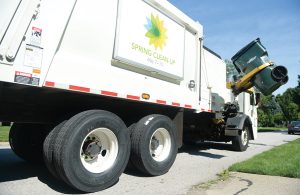Tires represent a major investment. Here is how to get the most out of them.

Whether traveling down city streets or entering and exiting transfer stations, waste haul trucks encounter a wide variety of conditions and surfaces. While it is difficult to control what waste haul truck tires roll over during their runs, waste haul fleet managers can—and should—take a proactive approach to truck tire maintenance.
Quite simply, proper maintenance is essential to optimizing a fleet’s tire investment. And the foundation of any waste haul tire maintenance program is inflation. Consistent, correct inflation positively impacts casing life, which is of particular importance to waste haul fleets that plan to extend the lifecycle of their tires through retreading.
Maintaining proper inflation levels also can slow down tire wear and help reduce the amount of fuel that waste haul trucks use. The benefits of checking—and, if needed, adjusting—tire pressure levels more than make up for the time and energy this practice requires.
Over or Under?
Waste haul fleets should avoid over-inflation and under-inflation. Both conditions alter a tire’s footprint, and not for the better. Over-inflation can result in a number of issues, ranging from irregular/fast wear to a harsher ride.
Under-inflation causes tires to flex more as they roll, which generates heat. Under-inflation also can lead to irregular and uneven tire wear and negatively impact a truck’s fuel economy, due to the simple fact that the increased rolling resistance caused by under-inflated tires forces a vehicle’s engine to work harder.
In addition, it should be noted that tires are engineered to run at specific pressure levels, based on the load they are required to carry.1 If questions remain, authorized commercial truck tire dealers are available for consultation. The tire professionals at these facilities can help evaluate truck needs and make appropriate tire recommendations.

Knowledge is Power
Truck operating speed also plays a role in the setting of optimal tire pressure. The tire industry offers guidelines for allowing increased maximum loads. Ambient temperature also has an impact on inflation levels, which can drop approximately 1 pound for every 10-degree decrease. This can be less of a concern during the summertime, but it is something to keep in mind as the year progresses, particularly among waste haul fleets that operate in northern climates.
Waste haul fleet managers should check inflation pressure levels at least once a week with a calibrated tire gauge or a gauge that is periodically checked for accuracy, according to tire industry recommendations.
Maintaining a careful record of tire inflation—plus inflation checks and adjustments—can prove beneficial, as well. An online tire management tool can help waste haul fleet managers track this key metric, whether they want to zero in on one tire or examine all of their tires, fleetwide.2
In short, truck tires represent a significant capital outlay for waste haul fleets and like any investment, should yield a profitable return. Frequent air pressure checks and adjustments can help accomplish this.
Evan Perrow is a Marketing Manager for The Goodyear Tire & Rubber Company and specializes in tires for waste haul applications. He can be reached at (330) 796-6677 or [email protected].
Note: To determine correct tire inflation levels, refer to tire load charts at www.goodyeartrucktires.com. Goodyear’s powerful Tire Trac is part of Goodyear’s Total Solution.
